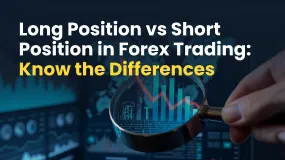7 useful ideas to improve your candlestick analysis
Abstract:Candlestick patterns are important tools in technical trading. Understanding them allows traders to interpret possible market trends and form decisions from those inferences. There are various types of candlestick patterns which can signal bullish or bearish movements.


Candlestick patterns are important tools in technical trading. Understanding them allows traders to interpret possible market trends and form decisions from those inferences. There are various types of candlestick patterns which can signal bullish or bearish movements.
Japanese candlesticks are one of the most popular chart types, along with bars and lines. The reason for their popularity is their simplicity and the importance of the information they provide for traders. Although a candlestick chart is easy to use, it has unique features—by learning about those features, traders will get more reliable and helpful information for their trading decisions.
Tip #1: Learn how to read candles
You may know that each candle provides information about open, close, high, and low prices. Candles have particular colors that help traders distinguish between falling and rising prices for each period. This means that you can easily identify the current market direction by looking at the chart. However, that‘s not all. You can get the signals not only from the color but also from the candle’s shape.
These common rules:
• A short candle body reflects market indecision, in which neither bulls nor bears can take control of the market.
• A long candle body shows the strength of bulls or bears depending on the location of the closing price relative to the opening.
• A long lower shadow says the bears are losing their strength. The signal is stronger if such a candle appears in a solid downtrend.
• A long upper shadow reflects the weakness of the bulls. The signal is more reliable if such a candle occurs in a strong uptrend.
• A candle without shadows or with one small shadow is called Marubozu. It reflects the strong market trend.
• These rules will help you do a quick market review without a comprehensive analysis.
• Effective strategies in your mailbox Subscribe and discover a fund of trading knowledge
Tip #2: Learn the most effective candlestick patterns
There are numerous patterns, but not all of them are effective. Moreover, you need to choose those that work for your own strategy. Candlestick patterns cant be equally effective for scalpers who open up to 100 trades within a day and position traders who keep trades open over weeks and even months. You should find the patterns with good results for a particular strategy.
First, you can start with the most popular formations, including evening and shooting stars, hammer, handle man, three black crows, three white soldiers, etc. If they dont provide reliable signals for your approach, you can try less common patterns. The idea is to set rules so that candles work for you.
Tip #3: Learn the most reliable chart patterns
There are candlestick patterns and chart patterns. While candlestick formations consist of up to 5 candles, chart patterns include many that make a particular figure in the chart. You may have heard of these formations: double top and bottom, head and shoulders, inverse head and shoulders, cup and handle, and inverse cup and handle.
The idea is the same: you need to choose those that provide the most reliable signals for your trading strategy. Even though there are the most frequent and reliable patterns, they may be ineffective for your trading style. To find the right one, you need to test numerous formations on different timeframes and for different assets.
Tip #4: Learn the frequency of continuation and reversal outcomes
Not many newbie traders know that even if a pattern is considered a reversal, it may signal a trend continuation and vice versa. Before you learn a particular pattern, try to find the information about the percentage of its reversal and continuation signals. If you cant find any, you can do your own research and use the historical data to identify whether the pattern worked in the past and what signals it provided.
Tip #5: Practice a lot to find patterns
It may sound like obvious advice, but the idea is to get used to different variations of patterns. You should remember that there are no perfect formations in the price chart. Markets are dynamic, and although the price repeats certain movements over time, they can‘t be identical. For instance, if the rule says the candle’s shadow should be twice its body, it doesn‘t mean you need to calculate the shadow and skip the pattern if it’s a little bit longer or shorter. Its even more difficult to spot chart patterns as the range of their variations is wide.
Tip #6: Use multiple timeframes
Traders use different timeframes to confirm signals of technical analysis tools. For instance, if the candlestick provides a reversal signal in one timeframe, you can consider a shorter one to determine the precise entry point. Usually, traders use three consecutive timeframes, placing an order in the middle one, evaluating the overall market trend in a longer one, and checking pitfalls for an entry in the shortest one.
Tip #7: Confirm signals
Regardless of the winning rate of the pattern, you need to look for confirmations from other technical analysis instruments or fundamental analysis events. For instance, if a candlestick pattern predicts a trend reversal, you can check whether fundamental events could trigger a change in the trend. Also, you can combine patterns with indicators. Trend and volume indicators can help you determine the probability of a trend reversal.
Takeaway
Candlestick analysis is one of the cornerstones of successful trading. If you learn how to read candles, you will be able to develop a working trading strategy. However, you should keep in mind that there is always a risk of a wrong signal or that you misread it. If the common rules always worked, all traders would have a 100% success rate. Take the time to analyze candlesticks and test your strategy numerous times before you enter the real market.

Read more

Should You Learn to Trade or Trust Someone with Your Money?
Should Malaysians develop their own trading skills or entrust their capital to professionals? Understanding the real risks behind both choices is essential to protecting your financial future!

Is Forex Trading a Scam or Do People Actually Make Money From It?
Mention the word forex in Malaysia, and you will often hear immediate reactions: “It is a scam”, “It is like a money game”, or “Everyone loses”. Is forex trading a scam, or do people actually make money from it?!

Long Position vs Short Position in Forex Trading: Know the Differences
When investing through forex, you often come across terms such as long position and short position. You may wonder what these two mean and how they impact your trading experience. So, the key lies in understanding the very crux of this forex trading aspect, as one wrong step can put you behind in your trading journey. Keeping these things in mind, we have prepared a guide to long position vs short position forex trading. Keep reading!

Check Yourself: The Costly Trading Habits Every Trader Must Fix
Are the trading habits you barely notice the very ones quietly destroying your profits, and could a single overlooked mistake be costing you far more than you realise?
WikiFX Broker
Latest News
Identity Theft in FX: FCA Flags New 'Clone' Broker Mimicking Fortrade
Oron Limited Regulation: A Complete 2025 Review of Its License and Safety
Trade.com Review & Complaints Hidden from New Investors! Tell Different Story
FXCM Broker ASIC Stop Order Halts CFD Sales
Exnova Exposed: Reports of Failed Deposits & Withheld Withdrawals from Traders
The "Profit Eraser" Clause: Why Traders Are Losing Their Gains with Admirals
Souq Capital Exposed: DFSA Warns of Fake Licensing Claims and Unauthorized Status
Is FXCC Regulated? Full FXCC Regulation Overview
Is Tiger Brokers Regulated? Investor Protection Guide
Tag Markets Exposed: Withdrawal Issues, Inflated Spreads & Market Manipulation Concerns
Rate Calc


